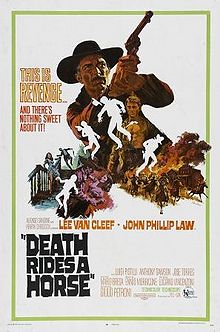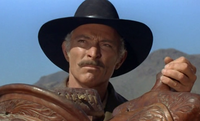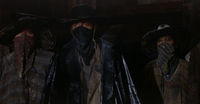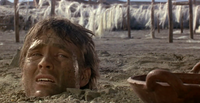Death Rides a Horse Review
This Page is UNDER CONSTRUCTION, please return later

|
| DEATH RIDES A HORSE (1967) |
Cast:
Director:
Music:
|
Death Rides a Horse (Da Uomo a Uomo)
Like Tonino Valerii's Day of Anger, Giulio Petroni's Death Rides a Horse adopts the master/pupil plot from Sergio Leone's For a Few Dollars More. But while in Valerii's movie friendship eventually turned into rivalry and hatred, in Death Rides a Horse, quite on the contrary, feelings of rage and vengeance eventually turn into friendship and mutual understanding.

|
In the first minutes of the movie, nearly an entire family is slaughtered. The men are killed and the women are raped, but the youngest son, a boy of about six years old, is overlooked by the murderers. This sequence, supported by a haunting Morricone score and ambient sounds of a thunderstorm, followed by those of a crackling fire, is one of the most efficient and terrifying you'll ever see in any spaghetti western. In this aspect it's only topped by the massacre of the McBain family in Leone's Once upon a Time in the West. Then we jump-cut to a moment in time fifteen years later: near the place where the family was slaughtered, the boy, now a young man consumed by his desire for revenge (John Philip Law), practices his shooting skills. At the same time, in a chain gang, a middle aged man (Lee Van Cleef) is released after fifteen years of forced labor. We'll learn that he is after the same men, and when he stops at the graves of the murdered people and says he's sorry for the boy, we know that he's hiding a terrible secret and wonder what consequences this might have for both men. In the end Death Rides a Horse not only adds a new dimension to the revenge western, but also to Van Cleef's acting range: here he's asked to impersonate an emotionally crippled, middle-aged man who becomes aware that life is escaping him. In true Freudian style, he tells the young man that if he had a son, he would have liked the boy to be like him. Their uneasy cooperation becomes a therapy: by instructing the younger man, and helping him to fulfill his mission, he not only dispels his own demons, but gives Law, his 'adopted son', the opportunity to live the life he himself never had.

|

|
The opening scene, with the boy watching his family slaughtered, was probably inspired by Raoul Walsh' Pursued (1947), in which an amnesiac young man, Robert Mitchum, must try to unravel the mystery of his early childhood involving the violent death of his parents (Petroni denies this, and it’s not the only thing he denies). Law, clearly chosen for his good looks, didn't know how to ride a horse or to handle a gun when he arrived in Italy, so he was sent to the famous riding school of Lello Simonella, while a private 'maestro d'armi' (master of arms) followed him on the set. The script by Luciano Vincenzoni also needed some revisions. According to some (but not to Petroni) Antonio Margheriti rewrote a few scenes, while others were rewritten on the set by Vincenzoni himself, helped by both Van Cleef and Law as far as dialogue is concerned (the film was shot in English). Due to all this, the production threatened to go on much longer than expected, and Leone's assistant Giancarlo Santi was sent to Almeria to give Petroni a hand.
In the meantime, the bandits Van Cleef and Law are after, have become important men in society. In a country like Italy, in which the authorities are often described as 'tutti ladri' (they're all thieves) this is a meaningful narrative element. Let's not forget that the mafia (and its counterparts: camorra and n'dragheta) are often indicated as cosa nostra (our business, the idea behind this all is: we take care of our own business because the authorities cannot be trusted). The bandits who have become dignitaries clearly have appointed the authorities: when a sheriff wants to arrest Law, one of them says it was a clear case of self-defense and no arrest is made.
Like Petroni's own Tepepa (1968), Death Rides a Horse is a deliberately paced movie, slowly building up tension by adopting Leone's flashback structure, thoughtfully preparing its bravura finale that is quite unique within the genre. Petroni pervades his movie with an autumnal melancholic feel that already seems to anticipate the twilight spaghetti westerns of the very last stages of the genre, like Keoma (1976) and California (1977). Performances are excellent: like in Day of Anger and The Big Gundown Van Cleef proves that he was a better actor than he was given credit for. John Philip Law was often accused of being a one-note actor, but in this movie, he seems completely focused on the job. Luigi Pistilli is at his slimy best as a bandit leader turned politician; this is probably his best performance along with The Great Silence. Carlo Carlini's camera work is also very impressive; most interesting is a dusty ghost town in the middle of the Almeria desert, in which unwelcome guests are buried to their neck in the sand. Ennio Morricone's score is very unusual. Bizarre choral chanting is alternated with indistinctive eerie sounds and kettle drums. Raoul recorded a song called Death Rides a Horse, but in the film only the instrumental version was used.
Few films are perfect, or nearly so, and Death Rides a Horse does not belong to those few exceptions. The narrative is strong, but might still be a bit too drawn-out for some people's taste. I would say that overall the zoom lens has been used a bit too often and that all those rewritings on the set (and the help of the lead actors) have led to a certain overdose of one-liners. Distributed by United artists, it was a great success in the US, despite an (in)famous 'It's not so hot' review in the New York Times by A.H. Weiler, in which the film was pulverized. It has always been one of the more popular spaghetti westerns - usually in people's top 10 - and got a new boost thanks to Quentin Tarantino, who was heavily influenced by it when making Kill Bill. Not only did he borrow the name of the main character and the film's most famous line ('revenge is a dish served cold'), he also used parts of Morricone's score, the main theme being played when the Bride faces O-ren and her bodyguards at the house of blue leaves. Furthermore the opening scene, in which the young Bill watches his family being slaughtered, is referred to in the anime sequence, the skull necklace becoming a skull ring, belonging to the man with the samurai sword who kills O-ren's father. It is also referred to, more indirectly, during the first fighting scene, when the Bride says she doesn't want to kill her opponent in front of her child. The typical spaghetti western technique of heavily filtered flashbacks, accompanied by eerie, unsettling sounds, is used several times in the movie when the Bride is reminded of the massacre during her wedding. Petroni, by the way, thought Tarantino only took Morricone's score from his film, and, well, yes, maybe, who knows, some aspects of that ultra-violent opening scene. But he didn't care. Kill Bill was a boring movie anyway. Quite a character, this Petroni. Grumpy man, Great films.
Reviewed DVD: I watched, of course, the MGM release, the release we all have (or should have). The film has entered public domain in the US, so there are a lot of cheap boxes around with a fullscreen version of it. I don't ask you to avoid those boxes, some of them are a good buy, but watch this particular movie in widescreen. Despite a reduced bit-rate (it's a single-layer disc) the MGM DVD has good video quality; occasionally there are a few specks or other minor print damage, but this is never really an issue. Audio comes in five different languages, English, Italian, German, Spanish and French (all DD 1.0). I have concentrated on the English and Italian audio tracks; the English one is definitely the better of the two (and since the film was shot in English it's also the 'original' one). The Italian audio sounds a bit dull and starts up only after six minutes (until then you'll get English audio).
--By Scherpschutter



